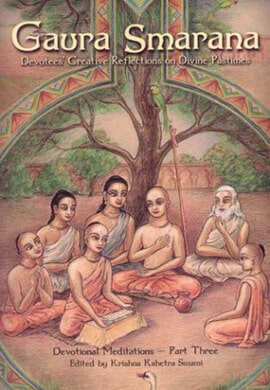Lord Shri Chaitanya Mahaprabhu’s pastimes are all uncommon. Whoever listens to his activities becomes glorious, and his life becomes perfect. (Shri Chaitanya-charitamrita, Madhya 16.201)
An invocation: As the awkward first steps of a small child are supported and encouraged by its parents, may our spiritual elders aid us in our attempts to glorify Lord Shri Chaitanya Mahaprabhu and his associates with these writings. And we pray that our readers may find inspiration to remember and reflect on the pastimes of the Lord from these pages.
In this third issue of the Devotional Meditations Series, we enter into the pastimes of Shri Chaitanya, who is known by his followers as Mahaprabhu, the “Great Master,” and whose activities are regarded as divine. Unlike Lord Rama and Lord Krishna, who appeared in ancient times, Mahaprabhu appeared in this world relatively recently, “within the memory of everyone” (in 1486, according to the western calendar). While it was Mahaprabhu’s express aim in life to spread the glories of Lord Krishna, those who followed him saw that he was the very embodiment of Krishna, or more precisely, that he was Krishna himself, living perpetually in the mood of Krishna’s dearmost beloved consort Shrimati Radharani. Among the several biographers of Chaitanya Mahaprabhu, Krishnadas Kaviraja has been recognized as the most important in plumbing the depths of Mahaprabhu’s life—both his more “external” activities and his internal, sometimes tumultuous experiences of Krishna’s love in the conceit of love-in-separation. Krishnadas’ Chaitanya-charitamrita has become the final authority on Chaitanya’s—also known as Gauranga Mahaprabhu’s—pastimes. Yet Krishnadas is resolute in his praise of Vrindavandas Thakura for his book, the Chaitanya-bhagavata. It is mainly from these two works that we, the contributors to this volume, have taken inspiration and prompting to reflect on, and then to express in our own words, what we appreciate from and feel moved by what we read. Often these reflections take the form of monologues or dialogues, in effect placing ourselves into the action, or else “giving voice” to witnesses (real or imagined) to the events and speeches described by the early biographers.
Some may doubt the value or propriety of writing in such ways as are found here, saying that it is best simply to hear or read and repeat the pastimes as they are given to us. We agree that it is good and right to do so, and we are happy if devotees continue in doing so, carefully following our previous acharyas. Our attempt here is not meant to detract from such faithful repetition, but rather, to enhance our own appreciation of the Lord’s unlimited pastimes. However minimal our adhikara (qualification) may be, we have met only strong encouragement from the Vaishnava community in response to the previous two issues of Devotional Meditations. The authors here represented are all dedicated practitioners of Krishna consciousness, bhakti-yoga, and typically they have practiced and studied the standard literature for many years. Still, we are the first to admit that we are not expert writers, hence one may find our efforts to be rather simple, perhaps naive, or unrefined. So be it. We take heart from the memory that once our Shrila Prabhupada kept a crude picture of Krishna done by a small devotee child before him as he chanted Hare Krishna japa while on an airplane flight. In a similar way, we hope that devotees will take pleasure in our crude efforts.
We will continue to take our baby steps in writing, expecting that one day we will be able to walk and run nicely—that is, able to more properly glorify the Lord through our writing. I think I can speak for many if not all of us who have contributed to this issue, that the effort to (re-)read and reflect on a particular pastime of Lord Chaitanya, and then to write our “creative reflections” has been both challenging and rewarding.
